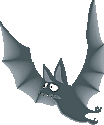|
| Diseases associated with caves |
|
|
People often ask if caves or cave animals are dangerous in terms of disease etc. I like to say no. However as with many environments, there are a few things to possibly be wary of. Histoplasmosis
Histoplasmosis is an infection that occurs from breathing in the spores of the fungus Histoplasma capsulatum. It is a threat to cavers as the airborne spores of Histoplasma capsulatum are found in guano. The lung infection, which is non-transmittable, can result from unusually heavy inhalation of the spores. The fungus thrives in warm (more than 20 - 24 °C) and moist caves and thick guano deposits are ideal breeding grounds. Histoplasmosis has been recorded from cavers who have visited tropical bat caves in many places such as Mexico, Central and South America, see this report from Jamaica. Malaysia is also an endemic region, though there have been few reports of cavers getting sick. I have certainly been infected with Histoplasmosis, as shown by a skin test, and could probably have got it from long stays in Mulu.
In caves, bat or swiflet guano is the obvious source, but I don't know if the hundreds of new man-made bird houses or swiftlet farms all over the country will also be breeding grounds for Histoplasmosis.
Bats as virus carriers
See page on Cave fauna 6 - bats for info on bats as virus carriers.
|
Leptospirosis or Weil’s Disease
Leptospirosis or Weils Disease is a disease caused by microorganisms and is commonly found in water. Leptospirosis has been making the news in Malaysia in recent years as a few people have died. Most of the victims seem to have caught the infection from contaminated river water. The Malaysian press describe it as a "rare and fatal bacterial infection". I'm not sure that it is accurate to call it rare, and it is not always fatal. "The disease is spread when water contaminated with the leptospira bacteria commonly carried in rat urine comes in contact with broken skin or the eyes. People at risk can be those taking part in outdoor pursuits in water and jungle trekking."
Some parks and waterfalls etc have been closed in Malaysia for the authorities to clean the area, but I don't know how they will do this, especially if the carriers are rats and other small rodents. Sarawak has reported quite a few cases.
In other countries, Leptospirosis or Weils disease is known to cavers as there have been a few cases of cavers catching it from caves over the years. See the Speleological Union of Ireland SUI info page. More general information is on the UK's Health Protection Agency HPA site. In temperate countries, the carrier is usually said to be rats. However in tropical southeast Asia, many caves are home to large bat colonies. If any bats are infected, their urine can contaminate the cave river and cavers can be at risk this way. See more on this page.
There are few people who go caving in Malaysia and also there are very few river caves. As far as I know it has never been caught/reported by the Malaysian public from caves. However there have been various cases amongst cavers in Mulu and Buda. The first ones were 16 explorers on the 1984 Mulu expedition, then 2 from Sarawak Chamber in 1985 (El Jalii & Bahaman). One case has been reported, a Caucasian caver who had been caving at Gunung Buda, near Mulu, for 4 weeks. Also, there was an outbreak of leptospirosis in more than 40% of the “Eco-Challenge” multisport race participants in Sabah in 2000. More than 35% were hospitalized but none died. Segments of the event included caving. However it is not known where the leptospirosis occured as other segments were held in jungles, rivers etc. See SEJVAR reference below.
Low oxygen / high carbon dioxide levels
A few caves I've visited in various countries have high carbon dioxide levels, or low oxygen levels. One such cave in Sulawesi in Indonesia, the cave was at ground level by a rice paddy and the CO2 levels were high. We think this was because the rice field had been burnt and this affected the cave air. Some lave tubes in the Dong Nai area of southern Vietnam have bad air. In other caves that have high CO2 levels, the cause is often bats. Bat guano can also give off high levels of ammonia. I have only once been in a cave in Malaysia with bad air, that was an old tin mine in Perlis. |
A News Item |
A News Item |
A News Item References :
CENTRE FOR DISEASE CONTROL Diseases Spread by Bats. url.
CRAVEN, Steven A. (2013) The epidemiology of acute benign pulmonary histoplasmosis (= cave disease). Cave & Karst Science, (BCRA), 40(3)133-140.
El JALII, I. M. & BAHMAN, A. R. (s.a.) A review of human Leptospirosis in Malaysia. (pdf)
MORTIMER, Roger B. (2005) Leptospirosis in a caver returned from Sarawak, Malaysia. Wilderness & Environmental Medicine, September, 16(3)129-131, 2005. text.
SEJVAR J, BANCROFT E, WiINTHROP K, BETTINGER J, BAJANI M, BRAGG S, et al. (2003) Leptospirosis in "Eco- Challenge" athletes, Malaysian Borneo, 2000. Emerg Infect Dis [serial online] 2003 June. url.
THAYAPARAN, Siva; ROBERTSON, Ian; AMRAAN, Fairuz; SU’UT, Lela; ABDULLAH, Mohd Tajuddin (2013) Serological prevalence of Leptospiral infection in wildlife in Sarawak, Malaysia. Short communication, Borneo Journal of Resource Science and Technology, (UNIMAS), Feb, 2(2)79-82. [Wind & Fairy Cave, Bau] |
A News Item 
© Liz Price 2013-2017
Last updated Dec 2017
|
|
|

